The ASRock DeskMini A300 Review: An Affordable DIY AMD Ryzen mini-PC
by Ganesh T S on April 26, 2019 8:00 AM ESTBAPCo SYSmark 2018
The ASRock DeskMini A300 was evaluated using our Fall 2018 test suite for small-form factor PCs. In the first section, we will be looking at SYSmark 2018.
Prior to describing the benchmark itself, we should quickly address concerns about using the benchmark to test AMD-based systems, given that AMD is not a part of the BAPCo consortium. In fact, AMD has been pretty vocal against the benchmark, with their last salvo appearing in 2016. AMD had quit BAPCo in 2011 over concerns of the GPU not being represented enough in the benchmarks.
Having analyzed the SYSmark 2018 white paper, and actually followed the execution of the benchmark workloads, we can say that SYSmark 2018 does represent possible usage patterns for a PC used in a business / office setting. Even if one were to side with AMD on the scoring aspect, the benchmark's rather unique energy consumption metric accurately represents the efficiency of the system for the realistic workloads. Overall, we believe that SYSmark 2018 is a good benchmark for systems used in certain scenarios; though it goes without saying that we never put too much stock in any one benchmark, which is why we only use it as one of out several benchmarks in our mini-PC reviews.
Anyhow, BAPCo's SYSmark 2018 is an application-based benchmark that uses real-world applications to replay usage patterns of business users in the areas of productivity, creativity, and responsiveness. The 'Productivity Scenario' covers office-centric activities including word processing, spreadsheet usage, financial analysis, software development, application installation, file compression, and e-mail management. The 'Creativity Scenario' represents media-centric activities such as digital photo processing, AI and ML for face recognition in photos and videos for the purpose of content creation, etc. The 'Responsiveness Scenario' evaluates the ability of the system to react in a quick manner to user inputs in areas such as application and file launches, web browsing, and multi-tasking.
Scores are meant to be compared against a reference desktop (the SYSmark 2018 calibration system, a Dell Optiplex 5050 tower with a Core i3-7100 and 4GB of DDR4-2133 memory to go with a 128GB M.2 SATA III SSD). The calibration system scores 1000 in each of the scenarios. A score of, say, 2000, would imply that the system under test is twice as fast as the reference system.
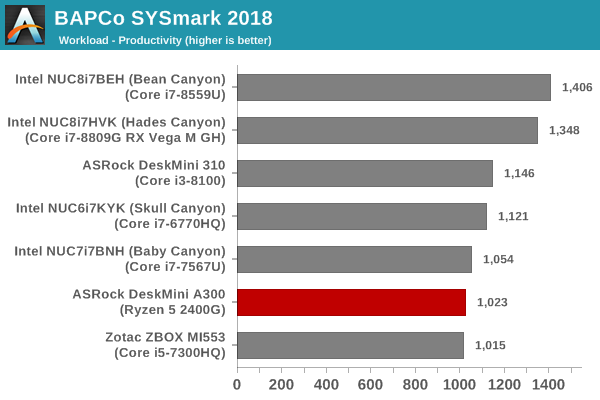
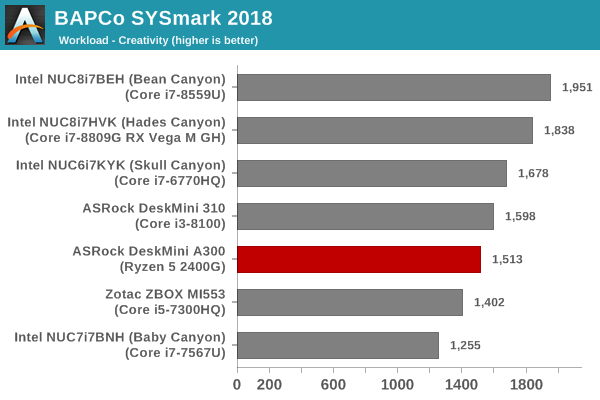
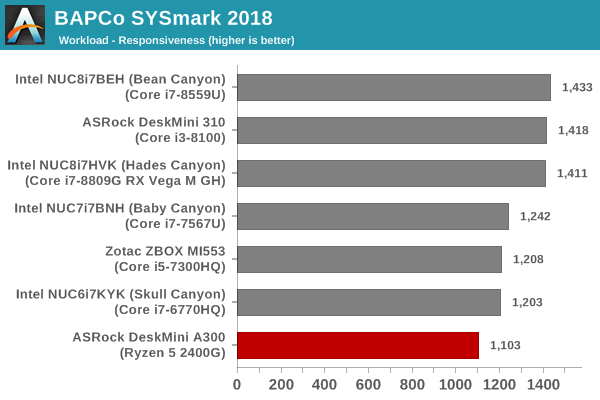
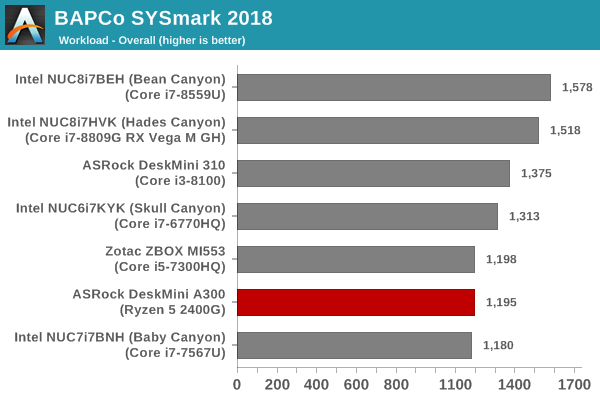
SYSmark 2018 also adds energy measurement to the mix. A high score in the SYSmark benchmarks might be nice to have, but, potential customers also need to determine the balance between power consumption and the efficiency of the system. For example, in the average office scenario, it might not be worth purchasing a noisy and power-hungry PC just because it ends up with a 2000 score in the SYSmark 2014 SE benchmarks. In order to provide a balanced perspective, SYSmark 2018 also allows vendors and decision makers to track the energy consumption during each workload. In the graphs below, we find the total energy consumed by the PC under test for a single iteration of each SYSmark 2018 workload. For reference, the calibration system consumes 5.36 Wh for productivity, 7.71 Wh for creativity, 5.61 Wh for responsiveness, and 18.68 Wh overall.
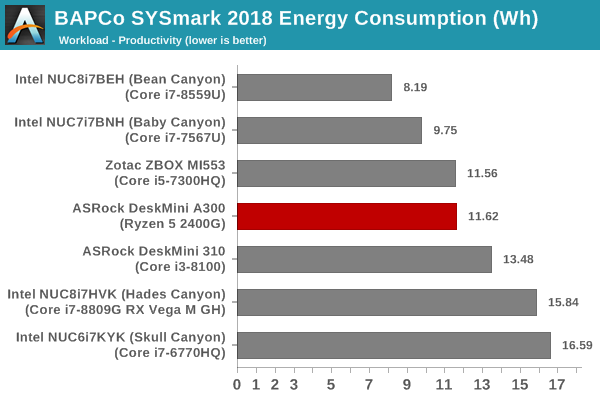


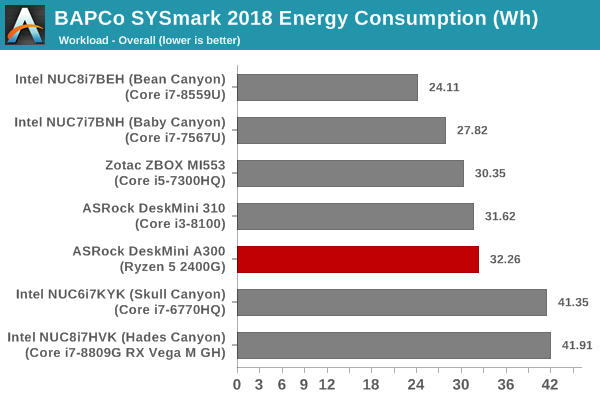
In the rest of the review, our focus will be on comparing the performance of the DeskMini A300 with the Ryzen 5 2400G and the DeskMini 310 with the Core i3-8100. Our builds for the system have approximately the same price point, and they are both contemporary systems. The overall energy consumption for the A300 is only slightly higher than the DeskMini 310, but the benchmark scores are lower. The DeskMini A300 configuration performs as well as the Zotac ZBOX MI553 (with the 45W Core i5-7300HQ) and the Baby Canyon NUC (with the 15W Core i7-7567U). However, those machines consume around 2 to 5 Wh less to achieve those scores.










88 Comments
View All Comments
BigMamaInHouse - Friday, April 26, 2019 - link
Comparing 2400G with Real iGPU vs $431 i7-8559U - I'd say it performs Great!.Irata - Friday, April 26, 2019 - link
To be more specific, on the "productivity benchmark", the A300 has 89% of the A310's score with 86% of its power consumption, so for office type tasks, it is actually a bit more efficient.ganeshts - Friday, April 26, 2019 - link
Ah, the pitfalls of saying ProdA scores X% of ProdB in metric M at Y% in metric N, when M and N are not linearly correlated!Extending it the same way, if I were to build the DeskMini 310 system with the same original review components at the current prices, I am going to splurge : 162 (DeskMini 310 board with Wi-Fi compared to DeskMini A300 without Wi-Fi) + 139 (Core i3-8100) + 76 (DDR4-2400 2x8GB SODIMM) + 78 (PCIe 3.0 x4 240GB NVMe SSD - Corsair Force MP510) = $455 ; Let me look up the table for the DeskMini A300 cost without Wi-Fi - tada, it is $465 - oh oh oh!!!! Does the lower upfront cost for the AMD system (as claimed in the article in the same BAPCo section) evaporate into thin air? No!
The reason is that when you are looking at SYSmark 2018 scores and SYSmark 2018 energy consumption numbers, you compare against systems that score approximately the same in those particular metrics.
For the overall SYSmark 2018 scores, the DeskMini A300 is approximately the same as the Baby Canyon NUC - then, let us look at the energy consumption numbers for those two - the Baby Canyon consumes lesser energy.
For the energy consumption numbers, the A300 and 310 are approximately in the same ball park - and there, you see the the 310 with a higher score.
As for accusations that 'Intel CAN"T be shown in anything other than their best light' - take a chill pill - the PCMark 8 numbers back up SYSmark 2018. And, in the gaming section, we show that AMD outperforms the best that Intel can offer. As an impartial reviewer, my aim is to present the facts as-is and provide my analysis - if you come with pre-conceived notions that one product / vendor is better than the other, then, no amount of facts will convince you otherwise.
Irata - Friday, April 26, 2019 - link
Replying to two different comments with one reply is a bit unfortunate as another poster made the "Intel can't be shown in..." comment.As for the price, if you check Newegg, the $150 A300 does include a Wifi kit.
Looking at Newegg prices, I get the following:
Desk Mini 300: $150
Desk Mini 310: $168
Ryzen 2400G: $150
Core i3-8100: $142
Memory: 100 (for the AMD system) vs. 80 (for the Intel based one)
note: I had a hard time finding the exact memory so I was looking at Team Group memory with roughly the same specs
WDS500G1B0C: $78
Corsair FORCE MP500: $130
When possible, in stock retail items with free shipping were chosen.
This gives me a total of $ 478 for the Desk Mini 300 (including WiFi) and $ 520 for the 310. But calling the price even would be OK, considering how prices can fluctuate.
MASSAMKULABOX - Monday, December 9, 2019 - link
AMd 150 + 150 +100 = $400INT $168 + 142 + 80 = $ 390 ... makes Intel cheaper , ..altho at this late date you can get the 2400g for $120 or less
Irata - Friday, April 26, 2019 - link
Second reply as I wanted to keep things separately.As I stated below, the comment regarding Intel having to be shown in the best light was made by another poster. Why could (she) have said this ?
For one, Intel is a client of your parent company Purch. They even mention this on their web site under "experience", stating "We’re focused on serving our action-oriented audience, as well as elevating the sponsor’s brand with that audience. We tailor the Native content that runs across our sites to better suit each environment, while keeping the integrity of the sponsor’s original content and brand."
In addition, you are using Bapco Sysmark, a benchmark that - given this "organization's" history - leaves a rather bad taste.
Now, I am not attacking your personal or journalistic integrity, however you must admit that the though AT may not be impartial does cross ones mind.
And this does not have to be overly obvious shilling (as that would be counter productive), but can be small nuances or tones, stressing one thing while leaving out another.
Do I have a pre-concieved notion of which one is better ?
Besides seeing the Intel iGPU as inferior (with the exception of video encode / decode) not really, but I admit that I do not particularly like Intel as a company
Ryan Smith - Friday, April 26, 2019 - link
"Now, I am not attacking your personal or journalistic integrity, however you must admit that the though AT may not be impartial does cross ones mind."Above all else, I think people vastly overestimate both how much work vendors are willing to put in, and how much they actually care about AnandTech. Being underhanded is a lot of work, especially for as small an audience as AnandTech has.
To be sure, there is a significant editorial firewall up between ad sales and editorial. I honestly couldn't even tell you about our (former) publisher's comments, because none of that ever involved AnandTech. It was probably a campaign that ran on Tom's Guide or such.
But regardless, we don't do shenanigans, and I won't stand for them. Vendors don't get to see articles early, we don't let vendors buy preferential treatment, and any sponsored content is going to be very clearly labeled as such. All AnandTech has its its honesty; so to sacrifice that would cost us everything.
Which, to loop back to the discussion of Sysmark, Ganesh uses it as part of his mini-PC evaluations. It's a pretty useful benchmark, especially for the energy efficiency metrics. It works well for what Ganesh needs, and the workloads seem reasonable. At the same time we're well-aware of the controversy surrounding it, and we'd never trust a single benchmark for a review - and certainly not Sysmark. Which is why we run many benchmarks, to look at different workloads and get different points of view on performance.
Irata - Saturday, April 27, 2019 - link
Thanks for the clarification Ryan. I still think that Sysmark is a no-go, but that's just my personal opinion.Smell This - Friday, April 26, 2019 - link
*As an impartial reviewer*_____________________
I snorted.
BPB - Friday, April 26, 2019 - link
I have one of these, and really like it. My problem is I bought this to replace an older NUC, and the older NUC runs Windows 8.1. I use the older NUC for WMC. Obviously the DeskMini doesn't support 8.1, but I thought I could get it to run 7. I can't. I noticed that ASRock has a utility for installing Windows 7 on AM4 motherboards, and I was given the impression that ASRock would update the DeskMini BIOS so I could install Windows 7. Then I found out the 2400G is only Windows 10 compatible. I don't know how I missed that when I did my research... So, my son gets nice little PC to replace his older one. This is a nice little setup, I just wish Windows 10 had something even 80 percent as good as WMC.